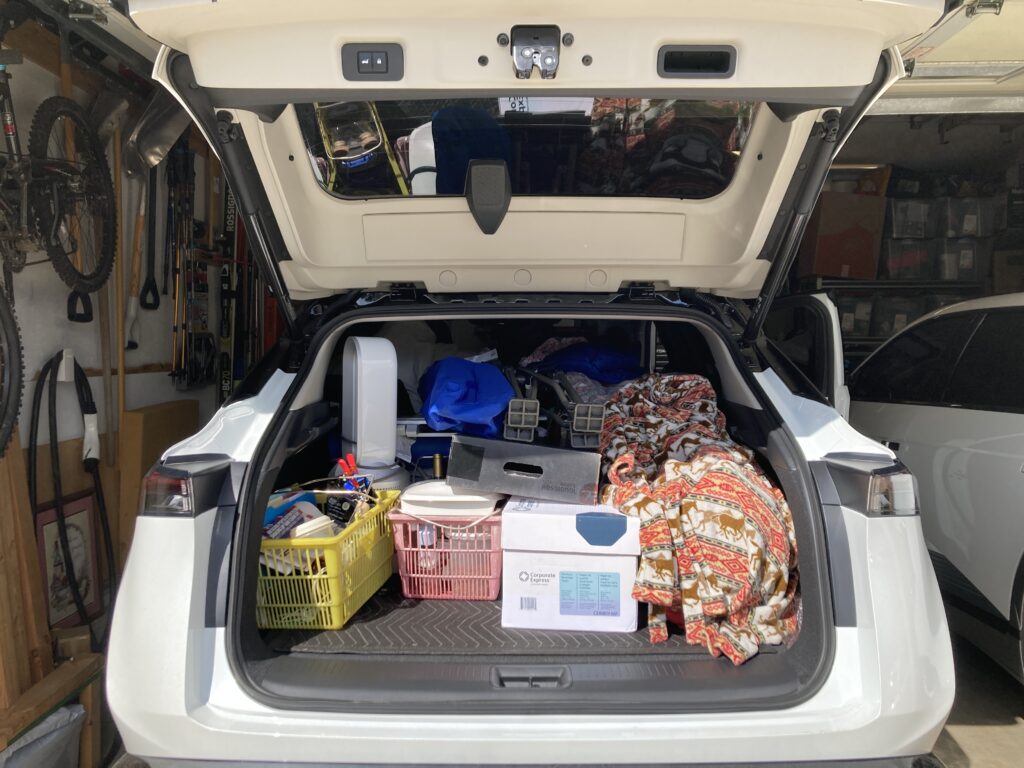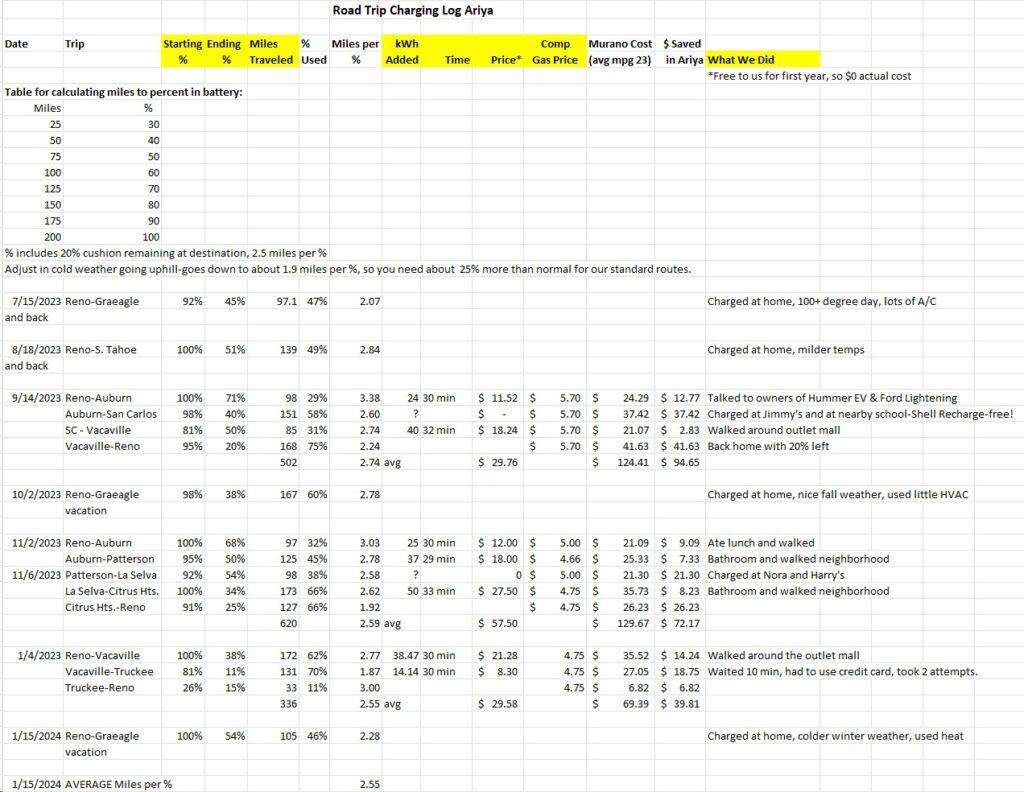We’ve had the Ariya for about 7 months now. What a great car! We are enjoying getting to know her and wanted to share what we have learned. We’ve been on 7 road trips so far and find that the Ariya is comfortable, dependable, versatile and solid. She handles well in the snow and has higher clearance and a stiffer suspension for off-roading than the Ioniq. The downside of this is that on the highway, the ride is rougher. The Ariya has a larger battery by about 20%, so it as a longer range, which is handy if you have longer gaps between charging stations. The cargo space is a little smaller than the Ioniq, but not much.
Here’s what it looks like when we load up most of our house and go to a rental place:

Charging
The Ariya comes with the EVgo network. Scott tried for a few months to test it out at the station in Reno, but it was never operational. On the road, we have found that EVgo doesn’t have as many fast charging stations as Electrify America, and seems to have more problems with down units. We did find a 350 kW charger in Citrus Heights, CA that we used in November and it worked just as well as Electrify America. Most of the time we use the Electrify America network that we get free with the Ioniq (works for both cars). We’ve had good luck with charging overall, only having to wait a couple of times. But we don’t typically travel at busy times, so that helps. We had one recent incident where for some reason the charger and the app were not communicating and we had to use a credit card. It stopped after a few minutes and we had to restart it again, but then it worked fine. Most of the time, we are charged up and ready to go within 30 minutes. We take that time to stretch our legs, use the bathroom and check our messages; sometimes we check out other people’s EV’s!
When it comes to charging, the only thing we find irritating about the Ariya is that it locks the charger onto the car and sometimes doesn’t want to let go. You have to press lock and unlock on the FOB sometimes more than once to release the cable. It also doesn’t charge as quickly as the Ioniq, but this is compensated for by its larger battery.
Overall, we have not had any problems with charging the Ariya (or the Ioniq) especially using the Electrify America network. We are lucky to have a lot of working stations on the routes we typically drive through northern California. But, the vast majority of the time, we are driving only in the Reno area and are charging at home off our solar panels.
Range
People are always asking us about the range of our cars. That’s an interesting question. It depends on a number of factors: how low you are comfortable going before recharging the battery; your driving style (more aggressive and fast driving uses more power); load (how many passengers, cargo, pulling a trailer); road conditions (flat, downhill, uphill, in-town vs. highway); outside temperature (colder temps decrease battery performance); use of climate control (heat uses more than A/C). EV’s are a different than gas cars in that they use more power on the highway and less in town, due to regenerative braking. This can be a challenge in figuring out how far your EV can go on a road trip, because it’s going to need more power than it uses at home. In general our cars can go from 175-200 miles, leaving us about 15-20% in the battery (our comfort zone). But, here’s the truth, we can only go about 150 miles before we have to get out! So we always say, our range is 150, which is less than our car’s! We plan our road trips around our needs, not the cars.
NOTE: The range quoted by manufacturers includes a mix of city and highway driving, so it will always be higher than you can actually go on a road trip. The EPA estimated combined range on our Ariya is 267 miles. But that would be draining the battery to 0%, which no sane person would ever do! Remember the 267 includes some city driving, so our 200 mile estimate in the table below is more accurate, leaving about 20% in the battery when you reach your destination. This is important if you have any question about finding a charger.
We have found it helpful to keep a road trip charging log so we can figure out how many miles we can actually go per % charge we have in the battery. Here’s the Ariya’s log so far for its first year:

At the top of the log, you will see that we have built a table based on the Ariya’s average miles per % in the battery (2.5%/mile), so we know how much of a charge we need to go a certain distance. This is a very helpful thing to know and can be difficult to figure out unless you have a log like this to tell you your average miles per %. For some reason, EV’s show you the mile per kWh which doesn’t really help you on the road. We have noticed that when we are going uphill in cold weather, we use about 25% more energy, so we need more of a charge to pull mountain passes, especially when it’s cold (see Citrus Hts-Reno and Vacaville-Truckee).
You can also see the difference between what it costs to charge the car with electricity vs. what the comparable ICE (Nissan Murano) would have cost in gas. In the three trips where we tracked this difference, there was over $200 savings! (NOTE: We actually didn’t pay for this charging, since we still have free charging for our cars. The only exception was when we had to pay by credit card in Truckee in January.)
Using Highway Driving Assist Systems
The highway driving assist system in the Ariya (ProPILOT 2.0) does a great job on regular highways of lane-keeping, lane changing, smart cruise control (adjusts speed to car in front of you), and allowing some moments of handfree driving (great for stretching your hands and wrists to prevent fatigue). It won’t let you keep your hands off for too long before it alerts you. The Ariya also watches to make sure your eyes are on the road and will alert you when your attention wanders. The Ioniq doesn’t have this feature, but does have all the other features in its HDA 2 system. What we prefer in the Ioniq is that it allows us better control on curvy mountain roads, like I-80. The Ariya tends to slow down, sometimes drastically, going into a curve and we have not been successful in finding a setting that will turn off this feature. The Ioniq does allow us to change this setting so it doesn’t do automatic braking going into a curve, allowing us to control the speed more fluidly. Because of this issue, we have given up on using ProPILOT in the Ariya while driving on mountain roads. Unfortunately, most of our long road trips include this kind of driving.
Future Road Trips
After 7 months with the Ariya and 18 months with the Ioniq, we decided we prefer the Ioniq for longer road trips, particularly those involving mountain passes. The Ioniq has the smoother ride and the better highway driving assist system, plus it charges faster. The Ariya we use for trips around our local area, like going to Graeagle, Lake Tahoe, Carson and Topaz. If we had a trip where we were planning more off-roading, we would definitely take the Ariya. We would also use it for a trip where we had more gaps between charging stations and needed the longer range. Scott prefers the seating and cabin in his Ariya for everyday use, but on a longer road trip he’s decided he would take the Ioniq. Both cars are a great drive overall and we recommend them to anyone interested in owning a quality EV SUV.
The Ariya Completes the Mother of All Road Trips!
An EV adventure couple just completed their Pole-to-Pole road trip in a modified Nissan Ariya! Yes, that is from the North to the South Pole–a trip of over 30,000 kilometers! Read about it here:
https://www.thenissannext.com/en/PoletoPole.html
https://www.washingtonpost.com/nation/2024/01/15/electric-car-north-to-south-pole-drive/
Or watch the video:
That is one beautiful car!!